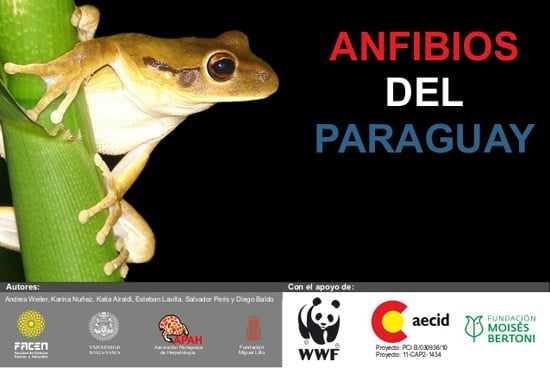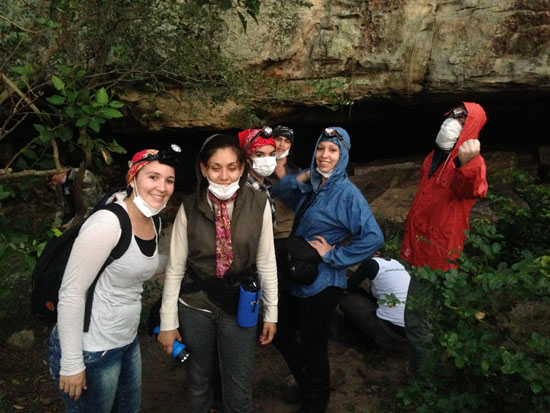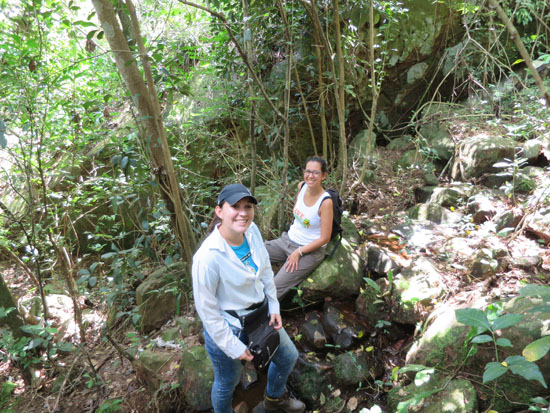On March 18th, 2016 I flew on an overnight flight from Cusco, Peru to Asunción, Paraguay. Frederick Bauer of the Asociación Paraguaya de Herpetología met me at the airport and took me to my hotel, where I ate breakfast and rested until the afternoon. I changed money and then caught a taxi to the Facultad de Ciencias Exactas y Naturales at the Universidad Nacional de Asunción, Paraguay’s largest university. I was greeted by eight undergraduate biology students with backpacks and rubber boots. My host Andrea Gabriaguez gave me a quick tour of the Faculty and introduced me to her professors, who generously presented me with a copy of their field guide “Anfibios Del Paraguay” (for which I will soon have a digital copy they granted me permission to distribute to the SAVE THE FROGS community!).

An official university van picked our group up and we headed east to Tobati, a 90-minute drive into the Chaco Húmido (Wet Chaco) ecosystem. Tobati is an inhabited valley with steep cliffsides on either side. We got dropped off at a farm (La Perla) where we set up our tents. We walked down the road a kilometer to eat pizza at the base of a cliff and then we put on our headlamps and climbed up a rocky path. The moon lit our way, and the constellations Scorpio, Orion and the Southern Cross were visible along with the Milky Way.
We were specifically in search of Leptodactylus syphax, a frog that lives in Bolivia, Brazil and Paraguay. In Paraguay, it’s only known population lives in this rocky area of Tobati. The cliffs have made it difficult for people to inhabit the upland areas, so the land on top makes great habitat for amphibians. It wasn’t long before we heard a loud chorus of frogs calling from some rocky pools. There were lots of Dendropsophus minutus calling from the vegetation above the pools:

Dendropsophus minutus
We found a single Leptodactylus podicipinus here as well:

Leptodactylus podicipinus
At the base of a cliff we came followed a series of ponds, where we found two species of Physalamaeus:


Physalamaeus albonotatus

Physalaemus biligonigerus (the only photo I got before he hopped away into the night)
Further down the path we encountered several large yellow frogs, Scinax fuscovarius:
Scinax fuscovarius
A beautiful lizard and dragonfly we found near the pools:


We continued down the path and came to an expansive open area where the exposed rocky earth was occasionally covered in bromeliads, cacti and palm trees, the preferred habitat of the juveniles of our target species Leptodactylus syphax, which we soon found:

Leptodactylus syphax
We took a temperature reading: 26C (79F). Pretty toasty for midnight! We scouted the upland area until 4am, finding frogs, geckos and tarantulas.

Phyllopezus pollicaris

On our walk home while descending the cliff we found a beautiful Leptodactylus gracilis:

Leptodactylus gracilis jumping
We got to sleep at 5am and slept until our tents got too hot to sleep. After lunch we walked down to the nearby river. We had a flute and drum jam and got some photos with the SAVE THE FROGS! flag:


We returned to our campsite. Danilo Krause of Vida Salvaje Paraguay had just finished teaching a course on how to safely handle snakes. He pulled out a few snakes that were with him:




We walked a few kilometers down the road to the town of Tobati, passing by the famous Guarani faces:

We found a Leptodactylus podicipinus juvenile near a pond by the road:
After an early dinner at the supermarket we hiked to the top of the cliffs west of town and headed towards the bat cave, arriving in time for a beautiful sunset:


We covered up before heading into the cave, as these bats like human blood and also if blood rips on us from the roof of the cave we could get infected with parasites that live in the blood. We found a couple large bats in the cave as well as a frog (Scinax fuscovarius).

To get out of the cave we crawled up a narrow shaft that had a about a foot of free space in which to move. I was happy to get out of the narrow cave and pull off all my hot bat-proof clothing! We found a scorpion on the walk back to the road:

At about 9pm we headed back to the area where we had searched for frogs the previous night. We found three snakes of the same species: Bothrops diporus (venomous!)


We returned to camp at 230am. The next day we hiked up the cliffside east of our camp.




I played flute overlooking the Tobati valley and then we headed back down the mountain:
We stopped for a break in the shade:

We returned to camp and packed up after an adventurous 48 hours! The next morning I woke early and headed back to the university to give a presentation organized by the Asociación Paraguaya de Herpetología.

About 25 students and professors were in attendance. I spoke for 75 minutes about amphibians’ natural history; threats to frogs; why frogs are important; ways to save frogs; and SAVE THE FROGS! worldwide activities. We took a break for photos and then I answered questions for an hour:



One question I received was can SAVE THE FROGS! help fund educational activities in Paraguay. I answered yes! I’m hoping you can help me raise $500 this week so I can provide a grant to these students to initiate SAVE THE FROGS! educational activities in Paraguay. Their first project will be educating students and teachers in Tobati about the importance of amphibians and ways to protect them. So if you enjoyed reading this story and agree that these students will do a great job representing SAVE THE FROGS! in Paraguay, please donate to SAVE THE FROGS! today. All donations through March 27th, 2016 will be directed to our Paraguay efforts. Thank you!
Together we can SAVE PARAGUAY’S FROGS!



